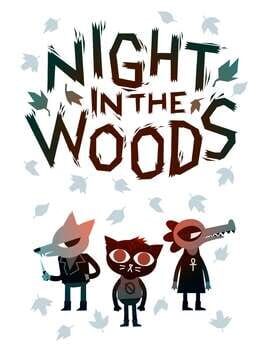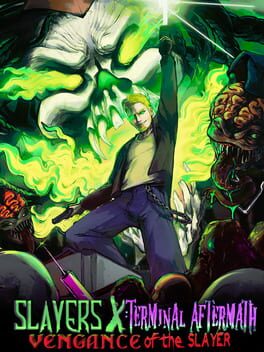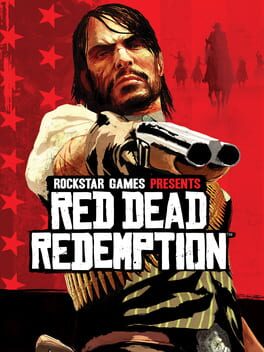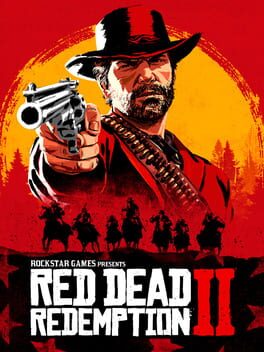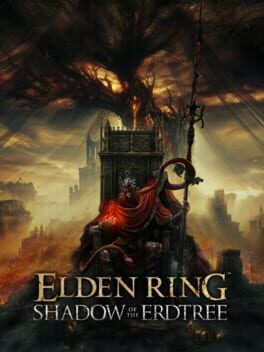UEObambam
2017
It's hard to give this game a fair review - part of me wants to say this should not have been a game and would have fared better in another medium. Its character-work its setting and its artistic choices are all gorgeous. It's hard not to fall in love with the cast of distraught young adults struggling to transition into the responsibilities of adulthood and holding onto the fun of their teenage years of not long ago.
There's a lot of times where I could not pay attention though, the core game as a walking side-scrolling simulator was hard to bare and I couldn't pick out the times I should be paying attention or times that are irrelevant to the plot and are there to further develop the world or characters. This was the second time I picked up the game and the first time I played it to completion. I don't understand the plot of Night in the Woods; I would need to replay its entirety again.
There is not much game to review, as the core loop is walking and chatting with characters, exploring the world through the eyes of the protagonist - having been removed from their small childhood town for a few years now. The minigames that pad it out and cut through the monotony are sparse in the core game, I think it could have done with more in the main span of the game as there isn't much else to do.
I love the setting, I love the art, I adore the characterwork, I have a hard time playing the game.
There's a lot of times where I could not pay attention though, the core game as a walking side-scrolling simulator was hard to bare and I couldn't pick out the times I should be paying attention or times that are irrelevant to the plot and are there to further develop the world or characters. This was the second time I picked up the game and the first time I played it to completion. I don't understand the plot of Night in the Woods; I would need to replay its entirety again.
There is not much game to review, as the core loop is walking and chatting with characters, exploring the world through the eyes of the protagonist - having been removed from their small childhood town for a few years now. The minigames that pad it out and cut through the monotony are sparse in the core game, I think it could have done with more in the main span of the game as there isn't much else to do.
I love the setting, I love the art, I adore the characterwork, I have a hard time playing the game.
This is a good 'bad' game. I don't have much experience with boomer shooters, but overall this was a really fun experience. I appreciate the unique weapon functions, like the glass cannon, where to get more ammo you are able to break windows and pick up glass shards off of the ground.
The story and art direction reeks of early 2000s middle/high school humor - but the writing is aware of this stench. The entire exigence was to take this middle school composition book game and the developer executed it decades later. The dialogue, the setting and the facilitation of gameplay is all crude and cringe - yet that's part of its charm.
I'm not fond of the charm but I appreciate what it goes for. It had two fully functional pianos in two separate levels as well - I was able to play the Buddy Holly riff and I'm very pleased with that.
The story and art direction reeks of early 2000s middle/high school humor - but the writing is aware of this stench. The entire exigence was to take this middle school composition book game and the developer executed it decades later. The dialogue, the setting and the facilitation of gameplay is all crude and cringe - yet that's part of its charm.
I'm not fond of the charm but I appreciate what it goes for. It had two fully functional pianos in two separate levels as well - I was able to play the Buddy Holly riff and I'm very pleased with that.
2023
Pesudoregalia was a very short game, but the mechanical intricacies of each power up made platforming around its castle setting awesome! Its art direction, while slightly disjointed still comes together into a coherent unit that enhances gameplay. If the gameplay wasn't so strong it's possible the rest of Pseudoregalia would fall apart. Its art combines fantasy, shown in its environment - the castle setting - with a UI inspired by 1920s art deco. It's gorgeous, but I didn't catch much art deco inspiration around the game's setting to tie the two together.
The semblance of a story this game has buried behind the aforementioned confused me a bit. I'm uncertain of what Pseudoregalia had to say. It's not a case where the game doesn't have a story, or it's there solely to facilitate gameplay, there is a story there. It's purposefully vague and doesn't give much info outside of beginning dialogue and the ending, which doesn't feel like enough to extrapolate.
I would more than likely have to replay the game to find the whys of the story and the whys of the art direction. With its short length, and its stellar gameplay, it is going to be a treat!
The semblance of a story this game has buried behind the aforementioned confused me a bit. I'm uncertain of what Pseudoregalia had to say. It's not a case where the game doesn't have a story, or it's there solely to facilitate gameplay, there is a story there. It's purposefully vague and doesn't give much info outside of beginning dialogue and the ending, which doesn't feel like enough to extrapolate.
I would more than likely have to replay the game to find the whys of the story and the whys of the art direction. With its short length, and its stellar gameplay, it is going to be a treat!
2010
After being fully engrossed with Red Dead Redemption 2, I immediately picked up playing Red Dead Redemption. The story follows Red Dead Redemption 2 after about 10 years had passed. Red Dead Redemption 1 by itself isn't as well written of a story as 2, but can hold its own well - offering a spaghetti western feel as opposed to the gritty slow burn outlaw story of Red Dead Redemption 2.
The spaghetti western feeling is felt in the arcade-like gameplay. Vastly different from its sequel, Redemption 1 offers fast pace shootouts, slick and quick horse riding and much faster travel, being condensed into a smaller map. The gameplay of 1 had me reconsider if I truly played the Redemption games in the right order. The gameplay evolved so differently than its sequel - maybe the slow burn that starts Redemption 2 would have been rectified if I played this one first. But having experienced the backstory, each story beat and reoccurring character recalled many emotions given from 1 and had me excited to see what would come next in this thrill ride.
The spaghetti western feeling is felt in the arcade-like gameplay. Vastly different from its sequel, Redemption 1 offers fast pace shootouts, slick and quick horse riding and much faster travel, being condensed into a smaller map. The gameplay of 1 had me reconsider if I truly played the Redemption games in the right order. The gameplay evolved so differently than its sequel - maybe the slow burn that starts Redemption 2 would have been rectified if I played this one first. But having experienced the backstory, each story beat and reoccurring character recalled many emotions given from 1 and had me excited to see what would come next in this thrill ride.
2022
Sonic Frontiers was a bit rough at launch, not having any options to adjust the gameplay. The core gameplay loop was very promising, and with a gameplay patch released soon after, the game felt phenomenal to play! The new "Open Zone" format of modern Sonic was much needed after the floundering of the boost. Offering creative freedom to solve the collectathon given to you at top speeds is exhilarating!
The story is good for a Sonic game, paying mind to the context of the entire franchise rather than attempting to live in its own little bubble. This writing feels like it would shaft a casual fan or a first time player of any Sonic game. As outside of the references, especially the off-hand character references, the writing isn't anything spectacular. It has very interesting ideas, and poses intriguing questions to the lore of the franchise, but the conflicts of the story doesn't carry a crazy amount of weight.
It's a shame then to point at the games atmosphere and lack of artistic direction. A criticism immediately poised since the gameplay trailers is the amount of floating debris around the levels. While they are fun to navigate, they are only there to facilitate gameplay and disconnects everything about the game's presentation. Standing around and looking at the world, it's crap everywhere! There is no story to why the obstacles are there, no worldbuilding, it's just gameplay when that cannot be all.
I say it now and I will keep saying it, if Sonic Unleashed's direction meshed with Frontier's gameplay, it would be the perfect modern Sonic game! But unfortunately, Sonic team can only seem to prioritize gameplay or art, rather than treat both as complements of one another.
The story is good for a Sonic game, paying mind to the context of the entire franchise rather than attempting to live in its own little bubble. This writing feels like it would shaft a casual fan or a first time player of any Sonic game. As outside of the references, especially the off-hand character references, the writing isn't anything spectacular. It has very interesting ideas, and poses intriguing questions to the lore of the franchise, but the conflicts of the story doesn't carry a crazy amount of weight.
It's a shame then to point at the games atmosphere and lack of artistic direction. A criticism immediately poised since the gameplay trailers is the amount of floating debris around the levels. While they are fun to navigate, they are only there to facilitate gameplay and disconnects everything about the game's presentation. Standing around and looking at the world, it's crap everywhere! There is no story to why the obstacles are there, no worldbuilding, it's just gameplay when that cannot be all.
I say it now and I will keep saying it, if Sonic Unleashed's direction meshed with Frontier's gameplay, it would be the perfect modern Sonic game! But unfortunately, Sonic team can only seem to prioritize gameplay or art, rather than treat both as complements of one another.
Red Dead Redemption 2 took an absurdly long time to get engrossed in. I attempted to get into the game back in 2021, but could not get through Chapter 2. With how slow the beginning way, I couldn't find myself getting hooked. In the first three chapters I spent a good chunk of time just having the game paused, watching videos and forgetting to close out of the game. My recorded playtime is 119 hours but it may be more close to 90, realistically. It wasn't until part way through Chapter 3 where the game and its story clicked. Each of the characters began to open up and the story really began to pick up. The conflicts became tangible and the characters banter and humor each other as the writing warms up. The real start of the game is at this point, and the rest is simply opening up the cold exterior of the outlaws. The story's ride reflects that of the characters, and as the story warms up in its humor, it heats up in turmoil. As the game ropes you in, tragedy begins to befall the cast of bandits and it rips at the heartstrings. Playing this right after Cyberpunk 2077 was not the right call because I was crying like a baby.
The gameplay, as slow and repetitive it may be, is the perfect compliment to the story. One gameplay feature I want to look at is the gunplay. Having to cock your weapon before firing, and getting familiar with said weapon. It emphasizes how methodical one needs to be, and asks the player to slow their roll, just like what the story does. It asks for a lot of commitment to warm up to, but when you do it is o' so worth it. The conscious direction for the game to take so long to get into, while brilliant, is unfortunately its main hindrance. I wouldn't know what kind of writing would be necessary to rectify the opening of Red Dead Redemption 2, but that is this games main flaw. Other than that single flaw, lovely game, wonderful story and an awesome time!
The gameplay, as slow and repetitive it may be, is the perfect compliment to the story. One gameplay feature I want to look at is the gunplay. Having to cock your weapon before firing, and getting familiar with said weapon. It emphasizes how methodical one needs to be, and asks the player to slow their roll, just like what the story does. It asks for a lot of commitment to warm up to, but when you do it is o' so worth it. The conscious direction for the game to take so long to get into, while brilliant, is unfortunately its main hindrance. I wouldn't know what kind of writing would be necessary to rectify the opening of Red Dead Redemption 2, but that is this games main flaw. Other than that single flaw, lovely game, wonderful story and an awesome time!
Shadow of the Erdtree is a drop dead gorgeous expansion for Elden Ring that makes sure you drop dead. The majority of the DLC is much more difficult than the base game, with enemies damage being turned up to two hit a 50 vigor character. The Scadutree Fragments are required to play without the punishing struggle, yet collecting them doesn't negate all struggle. It's still very difficult, but mostly manageable with the Scadutree Fragments. Exploring the entire map is still very much worth it and a puzzle in it of itself. The setting, the gameplay and the entire package gives the player a sense of absence, loneliness, and worry - it's masterfully crafted to invoke those feelings, while also inspiring the player with jaw dropping locations and landmarks to see. The Final Boss however truly feels hopeless however and soured the DLC for me. I understand the atmosphere the game goes for and how the gameplay enhances those feelings of dread, but the last boss goes too far, and takes those feelings away. The end of the DLC was disappointing and I did not have the drive to see the end of it. Despite that the DLC is still worth playing through as much of as possible, as it is truly a fantastic piece of art. The final boss was not fun though.
2010
I wish I could definitively say how many hours I have playing Skate 3. Might be one of the few games I can confidently say I have over a thousand hours, or more, in. Outside of very personal attachment, Skate 3 was genuinely amazing. Its gameplay was truly unique, only being emulated in recent years through much more difficult skateboarding sims like Session and Skater XL. Just like the previous games, Skate 3 had one of a kind gameplay, using the joysticks not only for movement but for the game's action. The Flick-It system is something I don't think any other type of game can replicate, and the endless possibility for creativity in its dense map is unbelievable. The map given in the game isn't even the end of it, with the Create-A-Park feature, possibilities for new skateboarding opportunities is truly infinite. Can't help but constantly pick up Skate 3 every once in a while, as it's still the best feeling skateboarding game with endless options to do new things.
Eons ago I played Bully's Xbox 360 release, and years later I remembered having a strong urge to replay it. Its art direction was phenomenal, reinforcing its setting and atmosphere of preppy private school. The musical score is one of the few video game soundtracks that I go back and listen to by itself - the music truly stands by itself. While the gameplay was relatively bare compared to Rockstar's other titles, its minigames with the various jobs around Bullworth, classes, and the carnival games were simple yet enjoyable and added a lot of life into the game. The minigames, while optional, allowed for a break in the main gameplay loop which extended my want to play the game. I would have to play it again to comment on its core gameplay, and the intricacies of the story, but I would be more than happy to play this a third time. The entire personality Bully holds is truly special, and I'm upset Rockstar never made a sequal.
